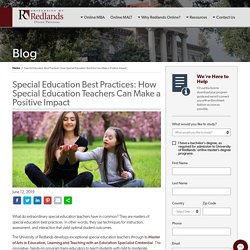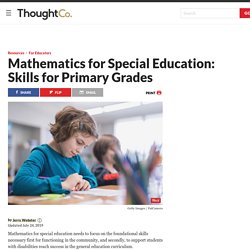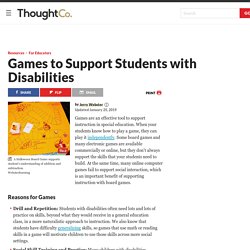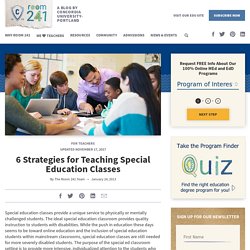

5 Ways to Use Technology in the Special Education Classroom. The ever changing world of technology has not overlooked the education system. New forms of technology find their way into our schools everyday. Whether using an Ipad, an Android tablet, a laptop or an interactive handheld game unit, there are many forms of technology that can be used to advance educational lessons.
Using Technology to Empower Students With Special Needs. One of the biggest problems I encounter as a resource room teacher is the self-esteem of the students in my classes.

After years of disappointing academic experiences, their confidence is low and their motivation has declined. Combine those points with the peer pressure, bullying, and stresses of middle school, and the students do not have a positive outlook on their education. What I’ve Learned From Special Ed Teachers. Special education teachers are expected to do quite a lot: Assess students’ skills to determine their needs and then develop teaching plans; organize and assign activities that are specific to each student’s abilities; teach and mentor students as a class, in small groups, and one-on-one; and write individualized education plans in parent-friendly language.
In addition, they must know and apply the dozens of acronyms used in their field: ADA (American with Disabilities Act), DOR (Department of Rehabilitation), LEA (local education agency), PDD (pervasive developmental disorder), and LRE (least restrictive environment), to name just a few. As I work with special education teachers, I remain awestruck by their energy, empathy, and excitement. Here’s what I’ve learned from them that has made me a better teacher. 1. Accept every student as they are. 2. 3. Special Education Best Practices: How Special Education Teachers Can Make a Positive Impact. What do extraordinary special education teachers have in common?

They are masters of special education best practices. In other words, they use techniques for instruction, assessment, and interaction that yield optimal student outcomes. [Special Education] 4 Teaching Best Practices. The use of blended learning models is becoming more widespread as educators strive to meet increasing expectations to personalize learning with fewer dollars.
![[Special Education] 4 Teaching Best Practices](http://cdn.pearltrees.com/s/pic/th/education-teaching-practices-208028854)
Proven Teaching Strategies for Special Education - Inspired Ideas - Medium. Students with special needs both require and deserve the most reliable, proven instruction that educators have to offer.

As a learning science company, we’re particularly passionate about identifying and creating reliable, proven instruction. For students with specific learning dis/abilities, ensuring we make the most of every moment spent in the classroom is all the more crucial to empowering them to thrive. Math for Special Education: Skills for Primary Grades. Mathematics for special education needs to focus on the foundational skills necessary first for functioning in the community, and secondly, to support students with disabilities reach success in the general education curriculum.

Understanding the way in which we quantify, measure, and divide up the material "stuff" of our world is fundamental to human success in the world. It used to be enough to master "Arithmetic," the operations of addition, subtraction, multiplication, and division. With the rapid growth of scientific knowledge and technology, the demands of understanding the "mathematical" definition of the world grew tenfold. The skills outlined in this article are based on the Core Common State Standards for Kindergarten and Grade One and foundational for both functional living math skills and for mastering the general education math curriculum. Counting and Cardinality. Games to Support Skills for Children with Disabilities. Games are an effective tool to support instruction in special education.

When your students know how to play a game, they can play it independently. Some board games and many electronic games are available commercially or online, but they don't always support the skills that your students need to build. At the same time, many online computer games fail to support social interaction, which is an important benefit of supporting instruction with board games. Social Skill Resource for Special Education. Students with disabilities can exhibit a whole range of social deficits, from merely being awkward in new situations to having difficulty making requests, greeting friends, even appropriate behavior in public places.

Effective Teaching Strategies for Special Education. This post has been updated as of December 2017.

Looking for effective teaching strategies for your special education classroom? These quick suggestions should come in handy for teachers working with special-needs students who pose certain challenges. Working with short attention spans Set clear expectations for all students.Break assignments into smaller pieces to work on in short time periods.Space breaks between assignments so students can refocus on their tasks.Share ideas with parents so they can help with homework.Carry out everyday routines consistently.Develop a reward system for good behavior, completing work on time and participating in class.Use visual and auditory reminders to change from one activity to the next.
This may need to be done several times before the change is made. Managing constant change Teaching effectively Being an effective teacher requires many tools, most of which you likely choose through trial and error. 6 Strategies for Teaching Special Education Classes. Special education classes provide a unique service to physically or mentally challenged students.

The ideal special education classroom provides quality instruction to students with disabilities. While the push in education these days seems to be toward online education and the inclusion of special education students within mainstream classrooms, special education classes are still needed for more severely disabled students. The purpose of the special ed classroom setting is to provide more intensive, individualized attention to the students who most need it. The Importance of the Arts in Special Education - Friendship Circle - Special Needs Blog.
Best Practices for Supporting Students with Special Needs. Veteran teacher and TeacherVision Advisory Board Member Tina shares her tips for helping students with special needs reach their fullest potential.

When teachers hear the term special needs, the most common type of educational disability probably comes to mind: a learning disability. This term, however, includes a host of diagnoses that can affect students in very specific, albeit very different, ways. A learning disability affects how kids process and comprehend information, and it can be expressed in a number of different ways. Students may demonstrate difficulty with spelling, writing, speaking, thinking, listening, or performing mathematical calculations. As a teacher, it is impossible to be an expert about every single possible educational obstacle your students might encounter. Read the Individualized Education Plan (IEP) This one seems like a no-brainer, but many teachers overlook the obvious when there are just so many things to do.
Does it take time? You need the Weekly Update. Best Practices for Teaching Special Education. Learning the best practices for special education gives teachers a crucial advantage in the classroom, where special-needs children face a broad range of difficulties in learning. The reasons for these difficulties are as unique as the children themselves. Teachers who understand the best practices can act appropriately to keep the learning momentum going forward. Here’s a look at how to make that happen in your classroom: Create a positive, safe learning environment By establishing the guidelines and boundaries in the classroom, the teacher sets the expectations for the students’ behavior. Let the students know precisely which behaviors are forbidden and which are rewarded.Make sure students understand that all will be treated equally under the rules of the classroom.Emphasize that positive behaviors are rewarded and other behaviors are not.
When the learning environment is rewarding, children can be motivated to stop misbehaving if they think they might be removed from the classroom. 10 Items Every Special Educator Should Have In Their Classroom - Friendship Circle - Special Needs Blog.